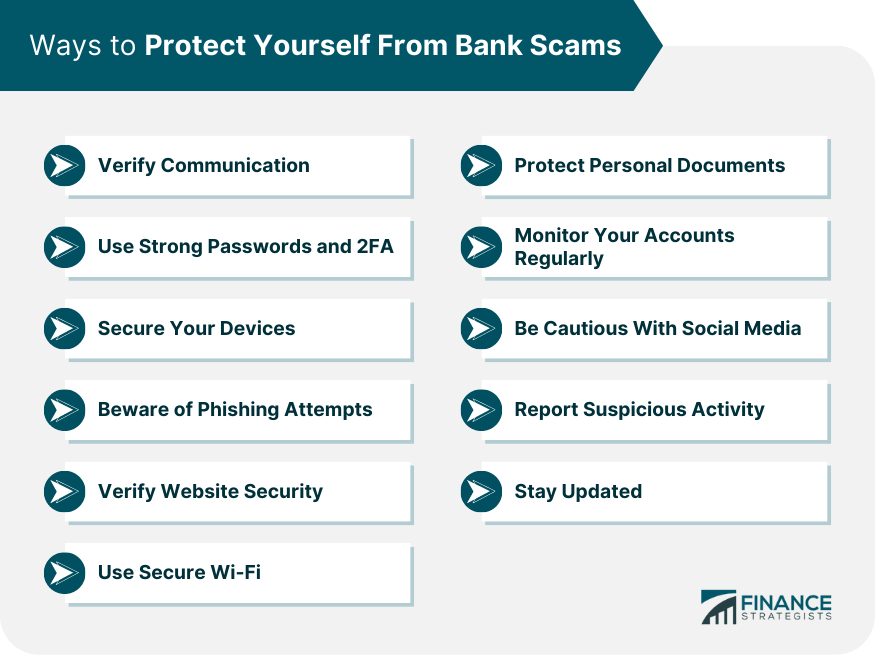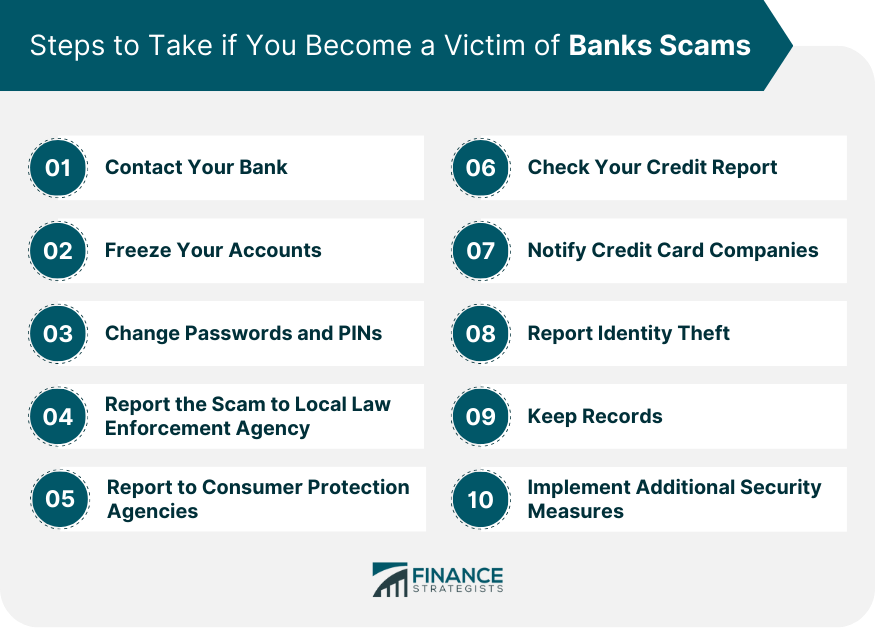A bank scam is a deceptive and fraudulent scheme that targets individuals' financial transactions, personal information, or assets for illicit gains. These scams come in various forms, exploiting technological advancements and digital platforms to trick unsuspecting victims. The purpose of bank scams is primarily driven by monetary gain, where scammers seek to access victims' bank accounts, credit cards, or other financial instruments to make unauthorized purchases. Understanding bank scams is crucial as it empowers individuals and organizations to protect their financial security, implement preventive measures, and maintain trust in the banking system. By being informed and vigilant, individuals can contribute to the fight against cybercrime and ensure their financial well-being remains safeguarded. Protecting yourself from bank scams is essential in today's digital age, where sophisticated cybercriminals continuously devise new tactics to exploit individuals' financial security and personal information. By following these specific and targeted steps, you can fortify your defenses against potential scams: Be extra cautious when receiving unsolicited emails, text messages, or phone calls requesting sensitive information or immediate action. Always verify the legitimacy of such communication by directly contacting your bank through official channels like the customer service number on the back of your credit/debit card or the official website. Strengthen your online account security by creating strong and unique passwords for each account. Avoid using easily guessable information and consider using a reputable password manager to keep track of complex passwords. Whenever possible, enable two-factor authentication (2FA) to add an additional layer of protection against unauthorized access. Protect your devices, including smartphones, tablets, and computers, with strong passcodes, PINs, or biometric authentication. Regularly update your operating system and security software to ensure you have the latest patches and protections against potential vulnerabilities. Be cautious of suspicious emails or messages containing links or attachments, especially if they claim to be from your bank or financial institution. Avoid clicking on such links and instead, manually type the official website URL to ensure you are accessing a legitimate site. When accessing your bank's website or conducting online transactions, check for the "https://" in the URL and a padlock symbol in the address bar. This indicates that the connection is secure and encrypted, providing an added layer of protection for your data. Avoid using public Wi-Fi networks for sensitive activities like online banking or shopping, as these networks are often unsecured and prone to eavesdropping by malicious actors. Instead, use a secure, password-protected Wi-Fi network or your mobile data for such transactions. Safeguard physical documents containing sensitive information, such as bank statements, tax documents, or identification papers. Store them in a locked drawer or a secure safe. When disposing of old documents, use a cross-cut shredder to ensure that personal details cannot be easily reconstructed. Regularly review your bank and credit card statements for any unusual or unauthorized transactions. Early detection of suspicious activity allows you to take swift action and notify your bank to prevent further damage. Be mindful of the information you share on social media platforms. Avoid oversharing personal details that could potentially be used by scammers to impersonate you or answer security questions. If you suspect any fraudulent activity or encounter a potential bank scam, report it immediately to your bank's fraud department and relevant authorities. Quick reporting can help protect not only yourself but also others from falling victim to the same scam. Remain proactive in staying informed about the latest scams and security measures. Follow your bank's security updates, sign up for email alerts, and read reputable news sources to stay abreast of emerging threats and fraud prevention techniques. If you become a victim of bank scams, it's essential to take immediate action to minimize the damage and protect your financial well-being. Follow these steps to effectively respond to the situation: As soon as you suspect that you have fallen victim to a bank scam, taking immediate action is crucial. Reach out to your bank or financial institution without delay and inform them about the fraudulent activity you have encountered. Be prepared to provide specific details about the scam and any unauthorized transactions you have observed. Many banks have dedicated fraud departments equipped to handle such situations, and they can assist you in taking the necessary steps to secure your accounts. To prevent further unauthorized transactions and limit the scammer's access to your funds, request your bank to freeze or block your affected accounts. Freezing your accounts is an effective way to halt any ongoing fraudulent activities and safeguard your remaining balance. By taking this proactive measure, you create a barrier that prevents the scammer from making additional unauthorized transactions using your compromised account. If the bank scam involves online access or account credentials, it is essential to change the passwords and PINs for all your accounts immediately. Create strong and unique passwords for each account, incorporating a combination of letters, numbers, and special characters. Changing your login credentials helps to revoke the scammer's access to your accounts and reinforces the security of your financial information. File a report with your local law enforcement agency or contact the appropriate fraud reporting agency in your country. This step is essential to document the incident and provide the necessary information for an investigation. In addition to notifying law enforcement, report the scam to consumer protection agencies or financial regulatory bodies in your country. These agencies are equipped to handle cases of financial fraud and can provide guidance and resources to help you recover from the scam. Reporting to consumer protection agencies also contributes to their efforts in monitoring and identifying patterns of fraud, which can lead to preventive measures in the future. Request a copy of your credit report from major credit bureaus and carefully review it for any suspicious or unauthorized activity. Look for unfamiliar accounts, credit inquiries, or other indications of potential identity theft resulting from the bank scam. If you find any discrepancies, report them immediately to the credit bureau and initiate the process of resolving fraudulent entries. If your credit card was involved in a bank scam, contact your credit card issuer promptly to report the fraudulent charges and request a new card. The credit card company can investigate the unauthorized transactions and reverse any fraudulent charges, ensuring that you are not held liable for the scammer's actions. If the bank scam resulted in identity theft, promptly report it to the appropriate authorities and follow their instructions for resolving the issue. Identity theft can have severe consequences, so taking immediate action is crucial to mitigate the damage. Work with the relevant authorities to restore your identity and prevent further misuse of your personal information. Throughout the process of reporting the bank scam and resolving its effects, maintain a detailed record of all communication with your bank, law enforcement, and any other relevant parties. This includes dates, times, names of representatives you speak with, and any reference numbers or case IDs provided. Keeping comprehensive records ensures that you have a clear account of the actions taken and aids in the resolution process. Consider implementing additional security measures to protect your personal information from future misuse. Options may include placing credit freezes or fraud alerts on your credit report, setting up account alerts for any suspicious activities, or using identity theft protection services. These proactive steps can help prevent similar incidents and enhance your overall security. Staying informed about various bank scams and being cautious of suspicious communications are crucial to safeguarding financial security and personal information. Implementing strong security measures, including unique passwords, two-factor authentication, secure device practices, and verifying website security, forms a robust defense against cybercriminals. Quick action is essential if you become a victim of a bank scam involving immediate contact with your bank, freezing affected accounts, changing passwords and pins, and reporting the incident to law enforcement and consumer protection agencies. Monitoring your financial accounts regularly and staying informed about the latest scams are vital in safeguarding your financial well-being. By adopting a vigilant and proactive approach, individuals can significantly reduce the risk of becoming a victim and contribute to a safer digital banking environment for all.What Is a Bank Scam?
How to Protect Yourself From Bank Scams
Verify Communication
Use Strong Passwords and 2FA
Secure Your Devices
Beware of Phishing Attempts
Verify Website Security
Use Secure Wi-Fi
Protect Personal Documents
Monitor Your Accounts Regularly
Be Cautious With Social Media
Report Suspicious Activity
Stay Updated

Steps to Take if You Become a Victim of Banks Scams
Step 1: Contact Your Bank
Step 2: Freeze Your Accounts
Step 3: Change Passwords and PINs
Step 4: Report the Scam
Step 5: Report to Consumer Protection Agencies
Step 6: Check Your Credit Report
Step 7: Notify Credit Card Companies
Step 8: Report Identity Theft
Step 9: Keep Records
Step 10: Implement Additional Security Measures

Conclusion
Protect Yourself From Bank Scams FAQs
To protect yourself from bank scams, stay informed about different scams, use strong passwords and two-factor authentication, and avoid clicking on suspicious links or sharing personal information with unknown sources.
Common red flags of bank scams include unsolicited requests for personal information, urgent demands for action, and offers that seem too good to be true.
If you suspect a bank scam, contact your bank immediately, freeze affected accounts, and report the incident to law enforcement and relevant authorities.
Secure your online banking by using secure Wi-Fi networks, verifying website security (https://), and avoiding public computers or devices for financial transactions.
Preventive measures include educating yourself about scams, being cautious with social media, and regularly monitoring your bank and credit card statements for unauthorized transactions.
True Tamplin is a published author, public speaker, CEO of UpDigital, and founder of Finance Strategists.
True is a Certified Educator in Personal Finance (CEPF®), author of The Handy Financial Ratios Guide, a member of the Society for Advancing Business Editing and Writing, contributes to his financial education site, Finance Strategists, and has spoken to various financial communities such as the CFA Institute, as well as university students like his Alma mater, Biola University, where he received a bachelor of science in business and data analytics.
To learn more about True, visit his personal website or view his author profiles on Amazon, Nasdaq and Forbes.













